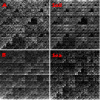A molecular study of microbe transfer between distant environments
- PMID: 18612393
- PMCID: PMC2442867
- DOI: 10.1371/journal.pone.0002607
A molecular study of microbe transfer between distant environments
Abstract
Background: Environments and their organic content are generally not static and isolated, but in a constant state of exchange and interaction with each other. Through physical or biological processes, organisms, especially microbes, may be transferred between environments whose characteristics may be quite different. The transferred microbes may not survive in their new environment, but their DNA will be deposited. In this study, we compare two environmental sequencing projects to find molecular evidence of transfer of microbes over vast geographical distances.
Methodology: By studying synonymous nucleotide composition, oligomer frequency and orthology between predicted genes in metagenomics data from two environments, terrestrial and aquatic, and by correlating with phylogenetic mappings, we find that both environments are likely to contain trace amounts of microbes which have been far removed from their original habitat. We also suggest a bias in direction from soil to sea, which is consistent with the cycles of planetary wind and water.
Conclusions: Our findings support the Baas-Becking hypothesis formulated in 1934, which states that due to dispersion and population sizes, microbes are likely to be found in widely disparate environments. Furthermore, the availability of genetic material from distant environments is a possible font of novel gene functions for lateral gene transfer.
Conflict of interest statement
Figures


References
-
- Raes J, Foerstner KU, Bork P. Get the most out of your metagenome: computational analysis of environmental sequence data. Curr Opin Microbiol. 2007;10:490–498. - PubMed
-
- Shinn EA, Griffin DW, Seba DB. Atmospheric transport of mold spores in clouds of desert dust. Arch Environ Health. 2003;58:498–504. - PubMed
-
- Falush D, Wirth T, Linz B, Pritchard JK, Stephens M, et al. Traces of human migrations in Helicobacter pylori populations. Science. 2003;299:1582–1585. - PubMed
-
- Powell B, Martens M. A review of acid sulfate soil impacts, actions and policies that impact on water quality in Great Barrier Reef catchments, including a case study on remediation at East Trinity. Mar Pollut Bull. 2005;51:149–164. - PubMed
-
- Baas-Becking L. Geobiologie of Inleiding Tot de Milieukunde. The Hague: Van Stockkum & Zoon; 1934.
Publication types
MeSH terms
LinkOut - more resources
Full Text Sources

